Menu
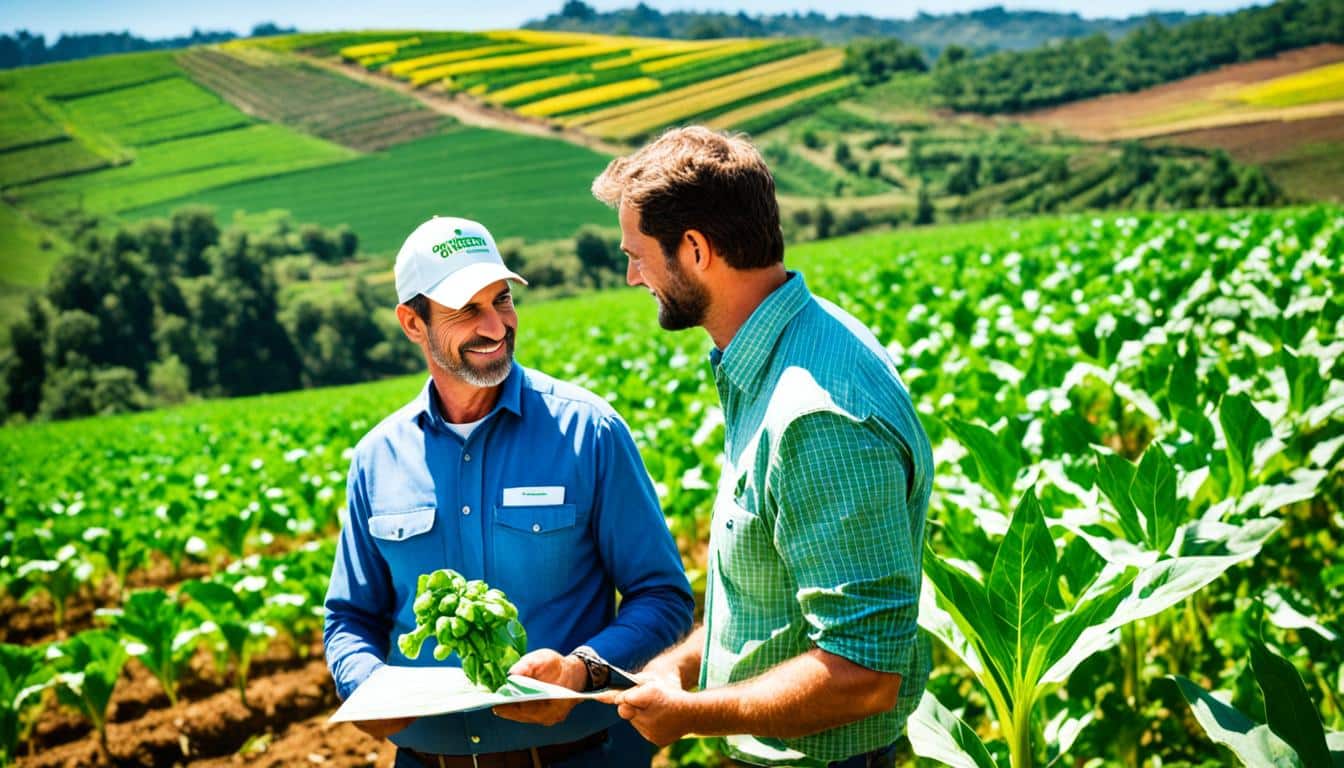
Did you know biotech brinjal technology in Bangladesh and the Philippines has helped farmers a lot? It’s given them pest-resistant crops quickly. Sustainable farming partnerships are making big changes for farmers. They are helping address problems like growing populations, protecting the environment, and lack of farm workers.
Public-private partnerships are all about working together to bring new ideas to farmers. This way, new tools are made just right for where they’re going. It also makes sure we use technology in the best way, helping farm communities a lot. For instance, helping with pest-resistant crops in Bangladesh and the Philippines has been a big success. As has the BioCassava Plus in Africa and biotech bananas in Uganda. All these efforts are making food more secure, farming better, and solving local farming problems.
By joining hands with top groups like the International Centre for Tropical Agriculture, the private sector helps a great deal. They teach farmers new things and help them with resources. Projects they support, such as in South Africa, are making farming better for the environment. This way, they are starting a chain reaction that makes farming more sustainable and fruitful.
Public-Private Partnerships (PPPs) in agriculture are collaborations. These involve government agencies working with private companies. Their goal is to improve farming and solve challenges specific to this area. By coming together, the public and private sectors can find better solutions. They are important for dealing with global food worries and managing resources well.
The World Bank defines PPPs as contracts between private and government groups. The private side takes on a lot of the risk and work. This setup aims to use the efficiency of private companies in creating and maintaining farming assets. Their key goals are to offer better services at lower costs and to bring in new ideas and technology.
PPP history shows a need to combine public and private efforts. This partnership can solve farming challenges much better than working alone. For example, a study in Uganda in 2007 highlighted the benefits of PPPs. It showed that private seed and processing companies, following specific government policies, really drive progress in farming.
Today, farms need to meet increasing food needs and protect resources. PPPs are now essential in reaching these goals through teamwork. Projects like the one with the International Maize and Wheat Improvement Centre and the Frijol Nica in Nicaragua are great examples. They show how working together can improve farming methods. This leads to better, sustainable growth. Also, private businesses are key. They provide what farms need, like seed and loans. This helps reduce poverty a lot.
Public-private partnerships are changing agriculture for the better. They bring the latest technology to farms. This helps in solving the many problems farmers face today.
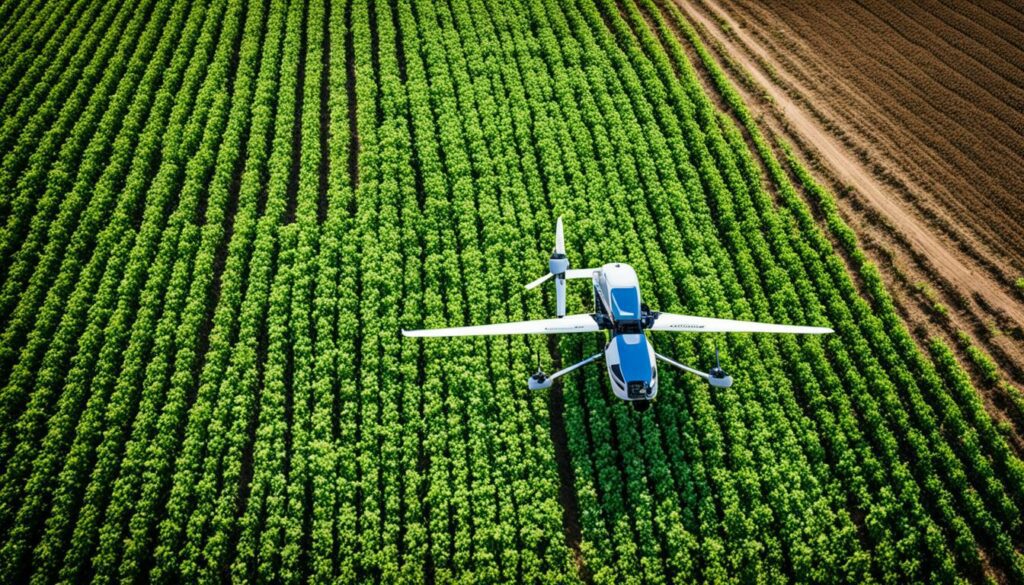
Innovations in technology boost farming. In the 1990s, Ireland’s food scene completely changed. It became a global example for safety, tracking food back to its source, and looking after the planet. This shift shows how important new ideas in farming are. Thanks to partnerships between the public and private, farmers can easily get the latest tools and techniques.
In 2017, Ireland hosted a workshop with farmers from ten African countries. It shared new ways to farm. This helps farmers worldwide. Also, in July 2019, African leaders met with business experts in Rwanda. They talked about making food systems better. This effort highlights how these partnerships can transform agriculture.
Using resources well is key to boosting farming. Partnerships in farming ensure new ideas and tech go where they’re most needed. This is crucial. For example, Kenya and Uganda are working hard to get businesses more involved in farming. These efforts came from international meetings. They show why using resources wisely is important.
The Food and Agriculture Organization (FAO) helps link up global partnerships. It guides businesses on developing agriculture. By working together, these groups make sure technology gets to farmers. This keeps agriculture moving forward sustainably.
| Country | PPP Initiative | Outcome |
|---|---|---|
| Kenya | Private Sector Engagement | Strengthened sector initiatives |
| Uganda | National Agricultural Investment Plan | Increased private sector involvement |
| Rwanda | Executive Coaching Event | Enhanced public-private cooperation |
| Benin | Access to Land Project | Improved land tenure security |
| Ethiopia | Advanced Maize Seed Adoption Program | 300% increase in productivity |
| Ghana | Mobile Training Unit | Expanded farmer training |
| Nigeria | Postharvest Loss Alliance for Nutrition | Reduced tomato losses |
| South Africa | GM Maize Adoption | Enhanced subsistence farming |
Public-private partnerships are crucial in bringing new tech and better use of resources to farming. Their work makes agriculture more modern, sustainable, and equips farmers with necessary knowledge.
Sustainable farming collaborations are making agriculture greener. They happen through partnerships between the public and private sectors. These help the environment and ensure farming stays sustainable in the future.
In Ireland, over 25% of people worked on small farms until the 1970s. Today, Ireland is a role model for food safety, traceability, and being green. Collaborations have been key to this change. For example, in Ethiopia, a partnership between private researchers and the University of Bern saves natural resources while growing tef.
Agriculture globally causes 27% of greenhouse gas emissions. These collaborations aim to lower this by promoting eco-friendly farming. In Brazil, public and private efforts support the use of eco-friendly soybeans, which helps agriculture locally and globally.
Over the last five years, regenerative agriculture has seen $2.61 billion go into 159 companies. More deals are happening, boosting sustainability. These public and private partnerships are key to reaching goals like creating stronger food systems and ending poverty.
In Africa, workshops and meetings in 2017 brought ten nations together to talk sustainable food systems. The FAO helped this effort, showing how important such gatherings are. As agriculture’s water needs are rising fast, these partnerships are essential for a green future in farming.
One big plus of these partnerships is cutting back on synthetic fertilizers. This helps reduce harmful CO2 and N2O gases. By working together, we make food more nutritious and protect our soil and water from harm.
Rural development initiatives are key for farming communities’ growth. They bring together public and private groups to make rural farming better. This helps local economies thrive and boosts farming in the area. The Rural Opportunity Investment Conference shows the focus on investing in rural America.
The U.S. Rural Infrastructure Opportunity Fund is a great example of working together. It brings private investment to key rural projects. These include things like schools, water systems, and broadband, really changing rural areas for the better.
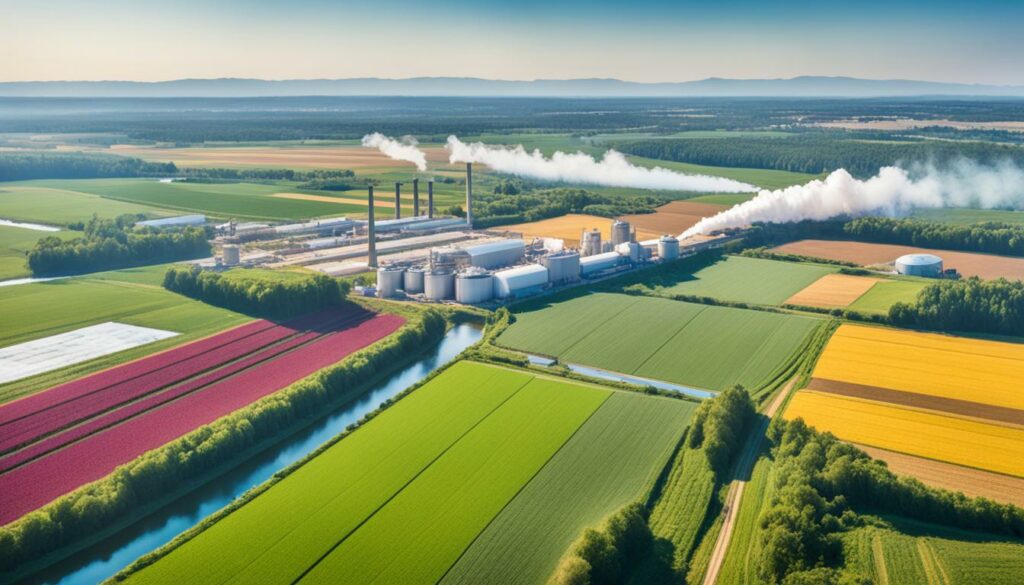
This fund teams up with the U.S. Department of Agriculture (USDA) to find rural projects that need funding. The USDA helps by linking projects to funds like this one. Thought it may spot the projects, it doesn’t give money to the fund or change its loan rules.
Around the world, many countries use PPPs for rural growth. Since 1999, Germany’s BMZ has been pushing these collaborations, showing great results. USAID and others are also working hard to join public and private efforts for rural gains.
Companies are choosing to do social good through these projects. They see they can help fight poverty and boost safety and green goals. This teamwork not only makes projects last longer but also builds trust in business. These moves improve life for farmers and their communities.
| Initiative | Objective | Support |
|---|---|---|
| Rural Opportunity Investment Conference (ROI) | Promote investment opportunities in rural America | White House Rural Council |
| Rural Infrastructure Opportunity Fund | Investment in rural infrastructure projects | Private sector dollars |
| Rural Business Investment Company | Facilitates private equity investments in agriculture-related businesses | USDA |
| BMZ PPP Programme | Promote public-private partnerships | German Federal Ministry for Economic Cooperation and Development |
Public-private partnerships (PPPs) in agriculture are doing a great job worldwide. They are solving big problems and making sure there’s enough food for everyone. They work by combining the strengths of public and private sectors. This way, they find solutions that fit the specific needs of farming challenges. Let’s look at some success stories, like the development of biotech brinjal in Bangladesh and the Philippines, biotech bananas in Uganda, and herbicide-tolerant soybeans in Brazil.
An outstanding example of how PPPs help is with biotech brinjal. In Bangladesh and the Philippines, they developed these special eggplant crops. They’re resistant to local pests, like the shoot and fruit borer. Because of this work, less pesticide is needed, and harvests are bigger. This has made a direct, positive impact on the lives of both farmers and the people who eat the crops.
Uganda is a great example where PPPs have made a difference with biotech bananas. These bananas are full of important vitamins and minerals. They help fight malnutrition in the area. The project also helped spread the use of these special bananas among small farmers. This way, more people enjoy better nutrition.
| Country | Project | Key Outcome |
|---|---|---|
| Bangladesh & Philippines | Biotech Brinjal | Pest-resistant varieties reduce pesticide use and enhance yields. |
| Uganda | Biotech Bananas | Improved nutritional content addressing malnutrition. |
In Brazil, herbicide-tolerant biotech soybeans are a big success story. This project showed how PPPs can improve farming. They made soybeans that suit the local farming conditions, making it easier to manage weeds. This helped the farm owners spend less on growing crops. Also, it was good for the environment as it lowered the amount of herbicides used.
These examples show that PPPs are key in making progress in agriculture through biotechnology. By working together, these partnerships find ways to solve tough agricultural problems. Their efforts improve food security and help the whole society.
In public-private partnerships (PPPs) in agriculture, the government is key. They make sure the path is clear for these partnerships to work well. By creating the right atmosphere, governments help these collaborations grow.
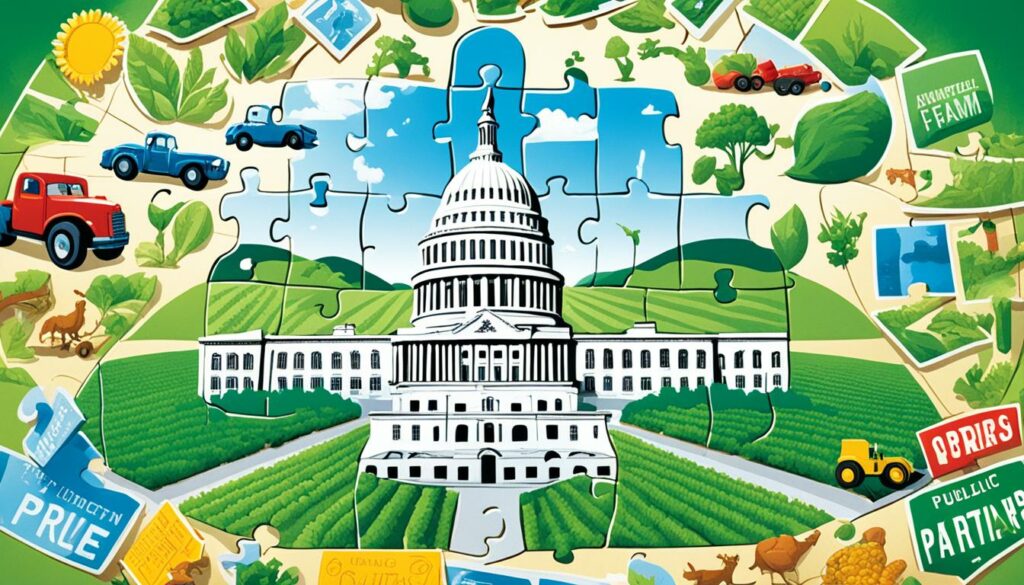
Good policy frameworks are a must for agriculture. Governments create rules and support to bring public and private sectors together smoothly. The guidelines by the FAO for public-private partnerships in agribusiness are vital. They support new and team-focused methods. In the 1990s, Ireland became a top spot for food safety and green practices. This change was driven by strong policy help.
Governments give perks to attract private companies to PPPs. These incentives are important for drawing in investments and interest. In Uganda, the plans for agriculture have strong backing from the FAO and the African Union. They aim to make private sector involvement better. In 2017, leaders from Africa met in Ireland. The goal was to boost partnerships and learn from each other.
| Government Role | Examples | Impact |
|---|---|---|
| Policy Frameworks | FAO Guidelines, Ireland’s Regulatory Policies | Enhanced Collaboration, Food Safety, Sustainability |
| Public-Sector Incentives | Uganda’s National Agricultural Investment Plan | Private Sector Engagement, Knowledge Exchange |
| Engagement Strategies | Workshops, Collaborative Projects | Productivity Growth, Cross-Sector Innovation |
By setting up policy supports and offering incentives, governments ensure PPPs help agriculture grow. This helps the sector now and in the future. It boosts productivity, saves the environment, and supports economic rise.
Agribusiness works together through public-private partnerships (PPPs). These partnerships show how joining forces boosts the agricultural field. They merge private sector skills and the public’s support to grow agribusiness in a sustainable way.
In Kenya, the Tissue Culture Banana Project is a great example. It combines tech and training to cut down on plant diseases. This effort shows the big impact of partnerships. It allows private groups to train local farmers in tech, making sure they can grow banana plants free from disease.
The South African Developing Agriculture Project is another good case. It brings private and public groups together to help farmers farm better and in a way that helps the environment. These partnerships push for new methods that make farming more productive. They also make sure that farmers can use the latest tech.
The International Potato Centre and USAID also team up internationally. They share farming tech to make potato farming better, ensuring food is secure in many places. This effort highlights the power of joining forces in agribusiness. It leads to better farm produce and a greener future.
Partnerships in farming are key for meeting big global goals. These include making food systems strong and getting rid of poverty. They bring together laws, science, and new ideas. This helps the world improve in farming and food.
Agribusiness partnerships do more than boost farm and food production. Look at how they changed Ireland’s food scene in the 1990s. By putting safety and the environment first, Ireland became a top example. This shows how much success partners in agribusiness can have.
Joint ventures in farming help by sharing both money and risks. When people combine what they’ve got, they can do more, creating new ways to run their farms. This means they can take on bigger projects without all the cost and risk alone.
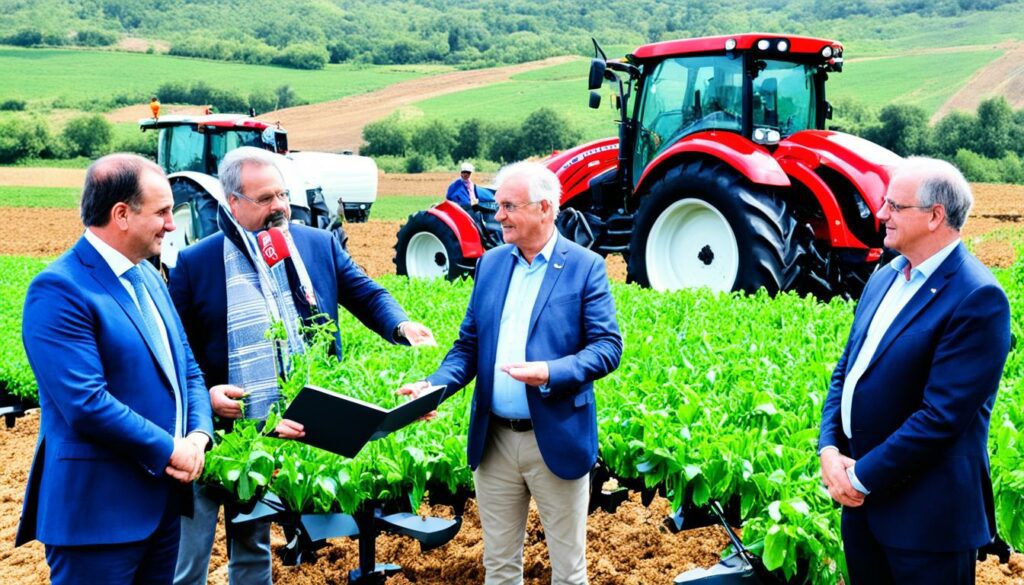
Working together in joint ventures means everyone shares the cost and danger. A study in 2010/11 found that out of 317 farm projects, 185 groups were working together. This approach includes 209 joint ventures and 108 independent operations.
Farms often form limited liability companies (LLCs) – 240 did in this study. This helps spread out the risk and brings more money to the table, making big farm projects doable.
Joint ventures can change farm businesses for the better. They can focus on many sectors, like grain sales and technology. For example, in Rwanda, these partnerships have helped develop new farming technology.
The FAO states that farm joint ventures are not as common as in other industries. But they play a big part in investing in new tech and building things like roads for farms. They really help agriculture grow in a smart way.
| Year | Total Ventures | Joint Ventures | Wholly-Owned Subsidiaries |
|---|---|---|---|
| 2010/11 | 317 | 209 | 108 |
| 2007 | 382 | 312 (LLCs) | 70 |
Joint ventures adapt well and can work for short or long times, like before a farm sale. They bring different strengths together, which reduces risk and sparks ideas in agriculture.
Public-private partnerships (PPPs) are vital in agriculture. They help share knowledge and technology with farmers. By working together, these partnerships make research and technology sharing more effective. This, in turn, boosts agricultural productivity.
R&D partnerships are key to many successful PPPs. For example, the E-Sahamathi project in Karnataka shares data from over 7 million farmers with start-ups. It creates new solutions suited to local needs. In India, using digital tools in agriculture could increase productivity by 23%. This shows how important tech-supported farming is.
Transferring knowledge effectively is crucial for PPPs to work well. NABARD in India is aiming to set up 10,000 Farmer Producer Organizations by 2027-28. They’re training these groups in smart pest control methods. In Latin America and Bangladesh, they’re also running projects with female advisors. These efforts make sure farmers get practical help, especially with climate change affecting so much of India’s farmland.
Then there’s the work of groups like the World Economic Forum. They’re pushing forward with projects such as AI4AI and Food Innovation Hubs. These projects encourage new farming ideas important for surviving and growing in the future. Getting better access to digital money and insurance can also really help farmers. It could lead to 10% higher profits and 40-60% less food waste. This shows just how critical sharing knowledge is for improving farming.
For more on how the private and public sectors are working to make agriculture better, check out this link.
Public-Private Partnerships (PPPs) play a key role in making food more secure. They do this by making crops more nutritious and resistant to pests and diseases. I have seen how working together can make a big difference in farming and making more food.
PPPs really shine when it comes to making crops healthier. Using the latest biotechnology, we are making basic foods with extra nutrients. This is vital where people often lack good food. Take, for example, sweet potatoes full of vitamin A and beans packed with iron. They are making a real health difference for whole communities.
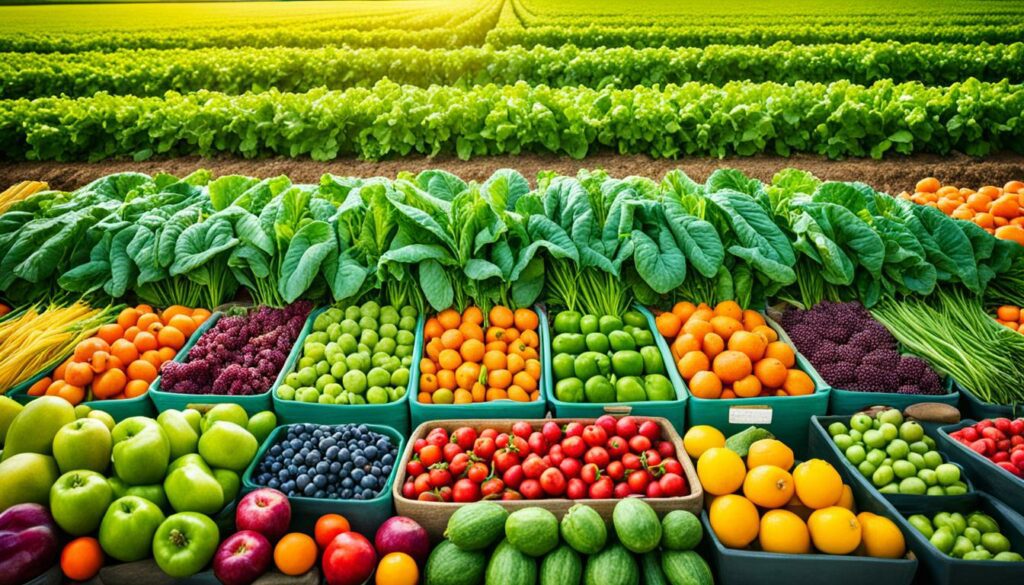
Working together through PPPs can upgrade crop nutrition strategically. For example, in Africa, we fortified sorghum with vitamins and minerals. This makes diets better, especially for those who need it most. Plus, enhanced rice and maize are fighting malnutrition effectively.
Making crops strong against pests and diseases is also a big deal in these partnerships. In Bangladesh and the Philippines, we developed brinjal that pests find hard to attack. This has cut down on lost harvests and the use of harmful chemicals. In Africa, wheat that fights diseases is making farming more stable, with more to harvest.
But, the real beauty is in how adaptable these new crops are. PPPs make sure the technology fits the local needs for fighting pests and diseases. This means crops can stand strong in a wide range of farm settings.
| Factor | Impact of PPPs |
|---|---|
| Food Security | Enhanced through integrated pest management and nutritional crop improvements. |
| Nutritional Enhancements | Delivered via biofortified crops rich in essential vitamins and minerals. |
| Pest and Disease Resistance | Achieved by developing and disseminating resistant crop varieties. |
Overall, by fixing both food’s nutritional value and making it safe from pests and diseases, PPPs help feed a growing world. This smart mix ensures farming moves forward in a way that really matters, sustainably feeding us all.
Public-Private Partnerships (PPPs) are key in helping agriculture grow in developing nations. They bring together the public and private sectors. This collaboration overcomes financial challenges and fosters new, creative solutions in farming.
The African Agricultural Technology Fund (AATF) leads projects to better farming in poorer areas. The Water Efficient Maize for Africa (WEMA) project is one great example. It focuses on creating maize that can survive droughts. This has helped ensure food for many in Africa.
The FAO and African Union work together to make farming more productive in Africa. They share ideas and strategies. Projects in countries like Kenya, Uganda, and Rwanda have seen these partnerships in action. For example, a 2017 workshop in Ireland helped ten African nations improve their public-private farming efforts. This strengthens their shared goals.
In Kenya, they are working hard to get more private companies involved in farming through a new plan. Uganda has a detailed strategy to bring in private sector skills for better agriculture. These steps, with help from the FAO, aim to improve farming’s impact on poverty and sustainable growth.
| Key Statistics | Details |
|---|---|
| Irish Small Farm Employment (1970s) | Over a quarter of the population |
| PPPs Case Studies Analyzed | 70 cases from 15 developing countries |
| Types of PPP Projects | Value chains, Research, Technology transfer, Market infrastructure, Business services |
| Workshop Participants (2017) | Ten African countries in Ireland |
The economic impact of PPPs in farming is massive. In India, the farming sector adds 20.2% to the economy. This shows how important it is for our economic health. As the need for food grows, so does the importance of PPPs to find new solutions.
Using technology in India’s farms could add $50-65 billion by 2025. The government has shown its support. In the 2021-22 budget, it promised to bring high-tech farm services through PPPs. These steps help PPPs in farming to grow faster.
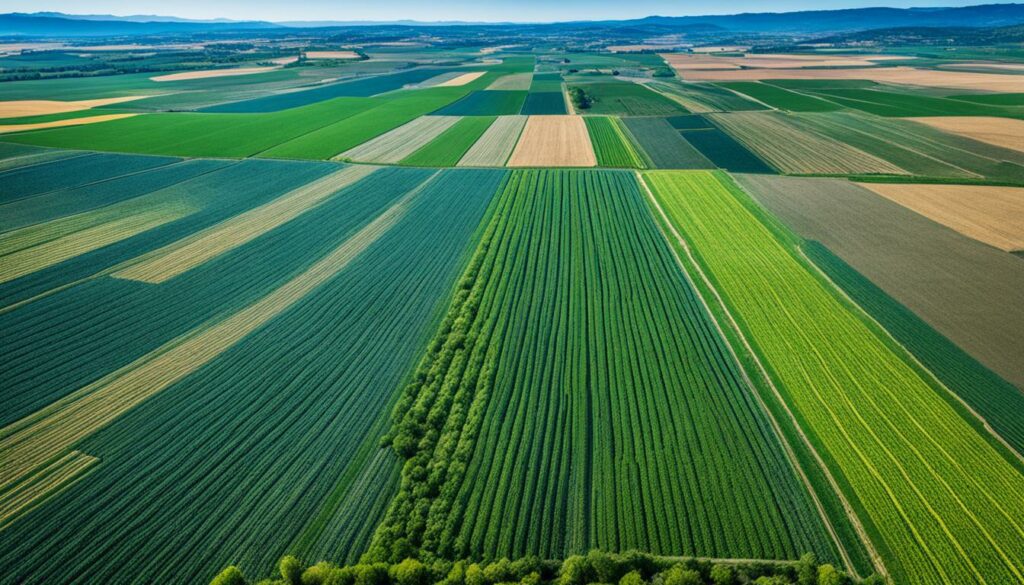
Private companies investing in farm technology and infrastructure see great economic rewards. Good partnerships reduce risks and solve big agriculture problems. For countries trying to develop, PPPs help them modernise and reach valuable markets.
There are global examples of PPP success, too. In Kenya, the Agriculture Ministry partnered more with private firms. In Uganda, they aimed for similar goals with support from FAO. These cases show that PPPs in farming are globally respected for their economic boosts.
Working together, the government and the private sector quickly improve farming. This lifts farm productivity and helps the economy sustain growth. PPPs have a direct impact on farmers’ earnings and the strength of the agriculture sector, showing their power in countries’ overall prosperity.
Implementing public-private partnerships (PPPs) in agriculture has its challenges. These partnerships offer great benefits but face tough obstacles. These hurdles need careful management to fully benefit from PPPs.
Finding funds for agricultural PPPs is a big challenge. Many projects are limited by financial barriers. It’s key to use new funding methods. This means governments and businesses must work together. They should use grants, loans, and investments to support farming projects.
Regulations can help or hinder PPPs. Tough rules, red tape, and delays can stop projects. To deal with this, policies should be made easier. Everyone involved needs to talk. This helps make rules that support PPPs.
Trust is vital for the success of agribusiness partnerships. Yet, it can be hard to build trust. This is because people have different goals and worry about honesty. In India, projects like ADEx and Saagu Bagu have boosted trust. They did this by being open with their data and working together. This shows how working together can build trust for future PPPs.
Solving these difficulties needs work from everyone. Focus on finding new ways to fund, making rules simpler, and building trust. This way, the impact of PPPs in farming can be maximised.
| Challenges | Solutions |
|---|---|
| Funding for agricultural PPPs | Adopt innovative funding mechanisms, leverage grants, loans, and investments |
| Regulatory hurdles | Streamline policies, create a conducive regulatory environment |
| Building trust between stakeholders | Maintain openness in data, align programmes across sectors |
Public-private partnerships (PPPs) in farming are moving towards big changes. They focus on using digital tools, AI, and the Internet of Things (IoT) in farming. Mixing these new technologies with old ways offers hope for the future.
Digital agriculture is changing the game. India wants to boost the agriculture sector to over 20.2% of its economy. By 2050, they might need 70% more from farmers. Digitech is the answer to meet these targets. In India, it’s expected to be worth $50-65 billion by 2025. This tech brings smart farms and better ways to sell produce. It could make farmers’ incomes shoot up. They can now check prices and weather fast, plus get advice online.
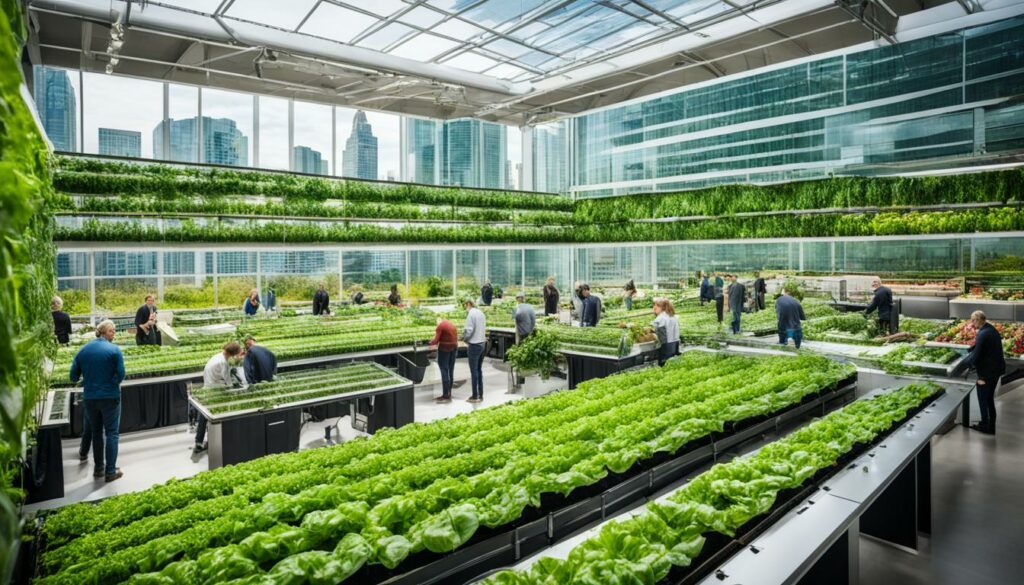
AI and IoT are shaking things up in farming. AI helps predict better crops and lower risks. Projects like AI4AI are leading this revolution. IoT is key in smart farming. It uses sensors to monitor soil and crops up close. This means farmers can use less while getting more. It’s tech for a greener future in farming.
PPPs are key in making these tech advances happen. They bring together the government and private companies. The goal is to help all farmers, big and small. This way, no one gets left out of farming’s future.
Looking ahead, these trends show farming will get smarter and more profitable. With digital, AI, and IoT working together, the future of farming looks promising.
Private sector involvement in agriculture is key for big projects. This work together leads to great changes, like those in Ireland’s food industry. Since the 1990s, Ireland has improved a lot in making food safer and the environment better. This shows how public and private groups working together (PPP) can really make a difference in farming.
The FAO has teamed up with Ireland and the African Union to help farmers in many places. In 2017, leaders from ten African countries met in Ireland to learn about PPPs in farming. This meeting helped find ways to get more business involved in agriculture.
In Kenya, the Agriculture Ministry is working hard to involve more businesses in farming. This fits with the big plan in Uganda that also wants more private businesses to help farming be more sustainable.
Good teamwork between the public and business helps reach important goals like ending poverty and making sure we have enough good food. The FAO has some tips for working together in farming, which include using new tech to grow and make food better. But sometimes, private companies are scared to invest in farming in new places without help from the government or big financial groups.
My time at the McKinsey Center for Agricultural Transformation taught me that using smart data and making plans based on facts really help. This way of working solves problems with how things are done. It depends a lot on having the right people, from leaders to farmers, who are ready for change. Everyone involved in farming can see good results with new, smart ways to do things.
The FAO’s plan from 2021 to 2025 highlights how important it is to work together. By getting private companies and the government to come up with new ideas, PPPs can make farming better in a long-lasting way. This mix of private and public efforts really boosts how well we grow food, the economy, and making sure farming is good for everyone and the planet.
Public-Private Partnerships (PPPs) in agriculture aim to deliver benefits to local areas. They do this by encouraging people to be part of farming. They also create jobs in rural places.
A great example is Bangladesh using female crop advisors. This effort helps local women learn and teach better farming methods. These projects also help spread farming knowledge, making it easier for more farmers to succeed.
In rural areas, PPPs also help by creating more jobs. In the Philippines and Bangladesh, better eggplants have both increased farming profits and made more jobs.
Also, in Ethiopia, a partnership led to better tef crops. This created new jobs in labs and farms. These examples show how PPPs benefit both society and the economy through smart community work and job growth.
Public-Private Partnerships (PPPs) are key in farming today. They bring together public and private sectors in farming. This partnership reduces costs and shares risks, making things cheaper for both sides. In countries like Australia and France, PPPs support research and form innovative groups. These efforts help create new farming methods that work locally. They also help small farmers, making farming better and more sustainable for everyone.
PPPs work towards crops that fit local needs. They use public backing for Research and Development (R&D). This is better than just giving subsidies. It changes how farming works and makes it more competitive. Grand Farm in the Netherlands grew its test area threefold in a year. This shows how projects quickly meet what the area needs.
Helping small farmers is a big goal of PPPs. These partnerships get help from businesses, processors, and NGOs. They help farmers get the tech, money, and markets they need. Grand Farm has many works with many in projects. This shows how PPPs can give farmers a lot of support. It makes farming more productive and food more secure.
PPPs make local farming better for everyone. By aiding small farmers, they boost food making. This helps make sure there’s enough food and helps economies stay strong.
Public-private partnerships in agriculture are key to starting sustainable farming. The field is under more strain, with the need for food set to rise 70% by 2050. This is due to more people needing food. The Indian agriculture story shows us how mixing technology with private money boosts the economy. It’s predicted to reach $50-65 billion by 2025, making a big difference.
Private money in things like land prep, tech, and tools, with help from the government, brings many good things through partnerships. These efforts make farming better, varying crops more, and tackling big issues like where to store food, water needs, and the cost increases from dealers. Public and private teamwork in agriculture surely makes farming stronger and more productive.
Although some still question their value, checking 70 cases in 15 developing countries shows real wins for everyone in these partnerships. Tips from work in Southeast Asia and Central America by FAO stress the huge need for new ideas to get more money in farming. By mixing the work of research centres and private companies in research and development, these team-ups are fundamental. They make sure farming grows in a way that helps both the economy and farmers. Diving into these smart collaborations and aiming at the future with solid plans will really pump up the perks of using PPPs in farming.
Public-private partnerships (PPPs) in farming make things lot easier. They share skills, tools, and support farmers. This way of working helps the environment and makes farms more productive.
It also helps rural areas grow and makes farming better overall. This happens through working together on things like planting and protecting crops.
PPPs in farming bring together the government and businesses. They work on problems by sharing what they know and their new ideas. The goal is to make farming better for everyone.
PPPs in farming came about because people saw that working together makes a big difference. By joining forces, we can find smarter ways to grow food. This is important for feeding everyone and looking after our planet.
PPPs help farms use the latest technology and tools. This improves how they grow and produce food. By staying up-to-date, farmers tackle challenges like the changing climate better.
They also meet the needs of a growing population. This means we can get more food without harming the environment.
PPPs that focus on being sustainable protect the planet. They use methods that are good for the Earth, like growing crops that need fewer chemicals. They also make sure farming can keep going for a long time without hurting the environment.
PPPs help places that are mainly rural get better. They bring new knowledge and technologies to these areas. This helps local businesses to grow and makes life better for the people living there.
Some good examples of PPPs include projects on important foods in places like Africa and South America. For instance, they’ve made plants that need fewer chemicals in Bangladesh and the Philippines. This has helped farmers and made food safer to eat.
The government helps by making sure that everyone works well together. They set the rules and make it easy for new ideas to turn into real changes in farming. This way, all the progress made really helps the farmers.
One example is the Project for Growing Bananas in a New Way in Kenya. Another is a big agriculture project in South Africa. These projects mix new technology with teaching to make farming better. They help grow more food and protect the land.
Working together in farming helps to lower the risk and cost of new projects. The big ideas become possible with joint ventures that might be too hard for one person to do on their own. This way, farming moves forward in big steps.
PPPs help farmers by sharing what changes farming in good ways. For example, they show how to manage pests without lots of chemicals. They also work on community projects to spread their know-how. This makes farming more efficient and better for the environment.
PPPs help make sure there’s enough safe food for everyone. They grow crops that are better at fighting off illnesses and bugs. For example, they’ve helped make wheat that’s not easily hurt by diseases. This way, we can count on having food to eat.
PPPs are a big help in places without as much money. They deal with issues like making sure there’s enough food, getting the right resources, and using new technology well. This includes working with organisations that help with these challenges.
PPPs help make farming and food businesses more worth in money. For instance, they’re making plans in India to use digital tools better. Ireland has also changed its way of making food to be more successful. These steps make a big economic difference.
PPPs have a few challenges to deal with. They need money, ways to follow the rules, and trust between the people working on them. Solving these problems means having clear and open ways to share information and plans. This makes PPPs work better.
The next big things in PPPs include using digital tools and clever technology. These new ideas will make farming even better and ready for the future. They’ll help farmers a lot by making their work easier and more efficient.
The private sector puts in its knowledge, money, and new technology to help farming change for the better. They work closely with the government’s plans. Together, they keep improving farming over time.
PPPs help local people by offering jobs and making their areas better. They work closely with the communities and help in setting up new plans. This makes life good for everyone around the farming areas.
Working together on farming projects makes sure local farmers get the support they need. They get to use new technology and finance that’s hard to get alone. This supports everyone doing the farming, making their work and life better.